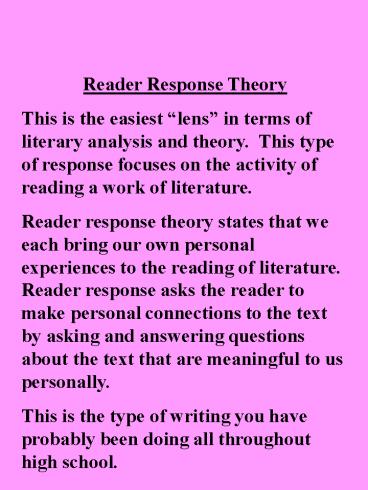Reader Response Theory PowerPoint PPT Presentation
1 / 7
Title: Reader Response Theory
1
Reader Response Theory This is the easiest lens
in terms of literary analysis and theory. This
type of response focuses on the activity of
reading a work of literature. Reader response
theory states that we each bring our own personal
experiences to the reading of literature. Reader
response asks the reader to make personal
connections to the text by asking and answering
questions about the text that are meaningful to
us personally. This is the type of writing you
have probably been doing all throughout high
school.
2
Reader Response Theory Reader response gives you
a voice. As long as you can defend your opinion
with textual support (using examples from the
text) then it is valid. It isnt an opportunity
or an excuse to go way out there and make up
crazy things that dont exist in the text.
However reader responses are usually very
different from each other. Because you are all
different, your personal responses to literature
will be very different!
3
Examples of reader-response type
questions What do I personally think that this
text means? Have I ever had an experience like
this? What did I learn from it? Have I ever
felt the way that the characters in this text
feel? What personal qualities or
characteristics do I have that might be relevant
to my reading of this text? Are my morals
reflected in this text? How are my morals the
different or the same as those highlighted in the
text? What issues are the most important in the
text? Why do I think these issues are the most
important? What words or phrases are most
important to me? Why?
4
What is this poem about?
Overnight, very Whitely,
discreetly, Very quietly Our
toes, our noses Take hold on
the loam, Acquire the air,
Nobody sees us,
Stops us, betrays us
The small grains make room. Soft fists insist on
Heaving the needles
The leafy bedding, Even the paving.
Our hammers, our
rams Earless and
eyeless, Perfectly voiceless,
Widen the crannies, Shoulder
through the holes. We Diet on water,
On crumbs of shadow.
Bland-mannered, asking
Little or nothing. So
many of us! So many
of us! We are shelves, we are Tables, we
are meek, We are edible.
Nudgers and shovers In spite
of ourselves. Our kind
multiplies We shall by morning
Inherit the earth.
Our foot's in the door.
Write 2-3 sentences explaining what you think
this poem is talking about. Then pick out the
stanza (verse of poetry) that is most meaningful
to you you like the sound of it, or it speaks
to you be prepared to discuss what you write!
5
The preceding poem is called Mushrooms and it
was written by Sylvia Plath. How did you come to
some idea of what this poem meant? Who you are
combined with what you are reading causes you to
create meaning. Lets look at a chart that
explains this concept
6
Reader-Response Diagram This diagram
graphically illustrates the principles of
reader-response theory. Under the READER
column, consider what personal characteristics,
qualities or history might be relevant to your
reading of the text. On the right side, under
the heading TEXT write what textual properties
affect your reading (such as use of dialect,
narrative structure, punctuation, sentence
length.) After completing the right and left
side, students then investigate how their
personal response and the characteristics of the
text create MEANING they write their
statements about what the text means to them in
the middle of the chart. (Appleman) READER MEA
NING TEXT
7
EXAMPLE Reader-Response Diagram READER ME
ANING TEXT
Here you write personal characteristics that
relate to the text you are analyzing.
Here you write characteristics of the text you
are reading such as vocabulary, sentence length,
type of literary work, punctuation
Together these make up the way a reader gets
individual meaning. Who you are and what you are
reading results in meaning.

